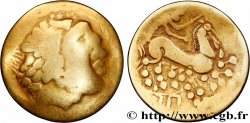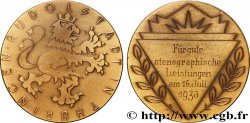Obverse
Obverse legend : ANÉPIGRAPHE.
Obverse description : Tête à droite ornée d'une couronne de lauriers partant du front et rejoignant la nuque.
Reverse
Reverse description : Bige à droite conduit par un aurige ; un triskèle, un foudre et un annelet sous les chevaux ; légende à l’exergue.
Reverse legend : [PHILIPPOY]
Commentary
Historical background
HOARD OF TAYAC - GIRONDE
These eight staters come from the same set, acquired in the first half of the 20th century and kept since in the same family.. Although the precise provenance has been lost, the composition of this set is strangely reminiscent of that of the treasure of Tayac. This treasure was discovered in Tayac, in Gironde, in November 1893; it was composed of torques broken in half, gold wire rolled into a spiral, 73 small ingots described as monetary blanks (7.60 grams), gold bars (of various shapes and weights) but above all 325 staters. The composition would have been about four-fifths Arverni stater (actually Aedui and uncertain from the west) and one-fifth Bellovaci (actually wide flan staters from the ambians). Unfortunately, "as many parts have been melted down", it is difficult to give a precise composition and distribution. "The Bordeaux museum has acquired, in addition to the torcs; two small ingots, two unminted coins, two coins struck on one side only, ten Arverne coins and one bellovaque". AT. Blanchet who describes this find on pages 561 and 562 of his Treatise was able to examine some coins from this find that MM. Rollin and Feuardent had in their hands. . . Unfortunately, the modern study of the treasure of Tayac, which is in progress (perhaps even completed, according to some) is slow to be published.. The author would have tried to reconstitute the whole, starting from the officially known coins and those passed since in the trade; certain batches (probably from samples taken by MM. Rollin and Feuardent) having seen the light of day, mainly in Vinchon and Bourgey sales during the 20th century. The set proposed and dispersed here presents coins constituting, according to A. Blanchet, the most represented coins in the treasury (for seven of them) but also a Venetian stater! If no Venetian coin is mentioned by A. Blanchet, the exhibition "Celtic Art in Gaul", from 1983-1984, a century after the discovery, gave a good part to this set by illustrating a torque, four blanks or ingots, 17 Aedui / uncertain coins from the West , two Ambian coins, but also two quarter staters and a Venetian coin. The exhibition catalog actually mentions a Venetian coin, acquired by the Bordeaux museum (see. "Celtic art in Gaul", cover, n° 145 pages 123-125). These concordant elements could seem insufficient to restore the provenance of these coins to the treasure of Tayac. . . this would be without considering the presence of an almost smooth coin with a corner break (?) illustrated on the aforementioned cover, above the stamp of the torque. This coin is to our knowledge unknown elsewhere, probably massively melted for its lack of iconographic interest. The coin of Bordeaux, whose provenance is certain, comes from the same coin as the one offered here! It is certainly regrettable to have to do with an exhibition catalog cover to study corner connections. . . but we are in France and the end justifies the means, failing to have a Gallic Sylloge. . . .








 Report a mistake
Report a mistake Print the page
Print the page Share my selection
Share my selection Ask a question
Ask a question Consign / sell
Consign / sell
 Full data
Full data





